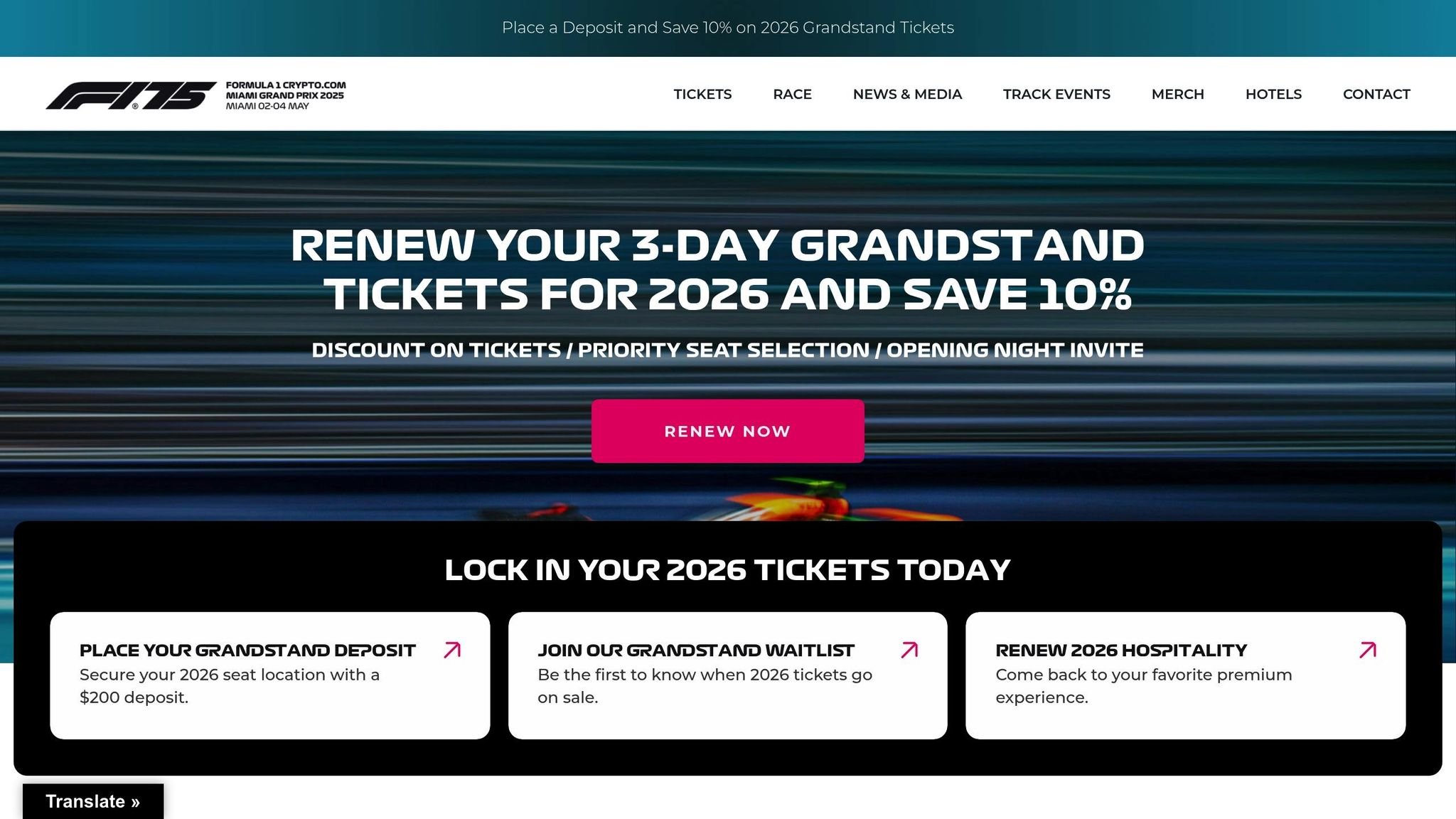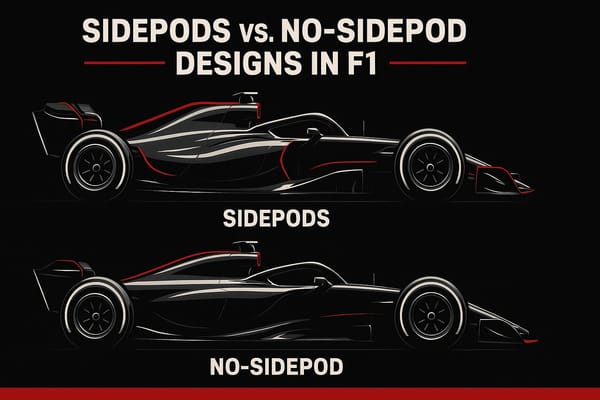Miami International Autodrome: The Newest Showstopper in F1’s American Dream
The Miami International Autodrome blends thrilling racing with significant economic impact, establishing itself as a key player in F1's U.S. expansion.

The Miami International Autodrome is Formula 1's latest success story in the U.S., blending thrilling racing with economic and community impact. Since its debut in 2022, the circuit has contributed over $1 billion to Miami's economy, secured a 10-year extension through 2041, and set records like 3.1 million U.S. viewers for the 2024 Grand Prix - the largest TV audience in F1 history.
Key highlights:
- Circuit Design: 5.412 km track with 19 turns, a 1.2 km straight, and unique elevation changes.
- Economic Boost: $449 million impact in 2023; projections suggest $500 million in 2025.
- Fan Experience: Integrated with Hard Rock Stadium, offering unmatched views and features like a gondola system.
- Challenges for Teams: High temperatures, abrasive asphalt, and tricky technical sections test tire and aerodynamic strategies.
This track is now a cornerstone of F1's expansion in the U.S., combining competitive racing with local culture and fan engagement.
Miami International Autodrome: A Glitzy F1 Venue or an Overhyped Street Circuit?

Circuit Layout and Facilities
The Miami International Autodrome spans 3.36 miles (5.412 km) and runs anticlockwise, combining elements of both street circuits and permanent tracks. With 19 turns and an average speed of just under 135 mph (217 km/h), the track offers a fast-paced and dynamic racing experience.
One of the standout features of the circuit is its integration with the Hard Rock Stadium complex. This design provides a unique viewing experience for fans. As Tom Garfinkel, Vice-Chairman of Hard Rock Stadium, explains:
"You could walk around the top deck of the stadium and see every corner on the race track – and that's pretty unique."
The track surface itself is worth noting. Its high limestone content creates an abrasive texture, posing distinct challenges for tire management. Elevation changes between Turns 13 and 16 add another layer of complexity, utilizing existing highway ramps and flyovers to introduce vertical movement into the layout.
One of the most exciting elements of the circuit is the 1.2 km straight leading into the Turn 17 hairpin, which serves as a prime overtaking zone. The track's hybrid nature demands a careful balance in car setup. Charles Metcalfe, an Apex design engineer, elaborates:
"It's notionally a street track with some really challenging corners, so you'd expect high downforce, but we have some really long straights and some high-speed corner sequences too that would favour a lower drag setup."
This balance is further tested in the technical sections of the track. Craig Wilson, FIA's Head of Vehicle Performance, highlights the diverse nature of the circuit:
"The sequence from Turn 11 to Turn 16 is tight and winding – the rest of the corners are a more typical mix of slow, medium and high-speed [turns]"
Adding to its distinctiveness, the venue features the first stadium-based gondola cable car system in the U.S., with 12 cabins transporting spectators over the circuit. The record-breaking viewership numbers reflect the track's growing popularity, setting the stage for further analysis of its impact on racing performance.
| Track Feature | Specification |
|---|---|
| Circuit Length | 3.36 miles (5.412 km) |
| Number of Turns | 19 |
| Longest Straight | 1.2 km |
| Expected Lap Time | 1m35s |
| Average Speed | 135 mph (217 km/h) |
| Direction | Anticlockwise |
Racing Performance Factors
Miami's circuit presents a unique set of challenges for Formula 1 teams, requiring meticulous fine-tuning of both tire and aerodynamic strategies. These factors significantly influence race tactics and outcomes, making the venue a tough test for drivers and engineers alike.
Tire Management Dynamics
With track temperatures often exceeding 131°F (55°C), tire degradation becomes a critical issue. The extreme heat accelerates thermal wear, particularly on softer compounds like Pirelli's C3, C4, and C5, which were introduced in 2025 to offer more strategic flexibility. The circuit's blend of long straights and tight corners further stresses the rear tires, as increased sliding during cornering amplifies wear.
These tire challenges demand a precise balance in aerodynamic setups to minimize strain and optimize performance.
Aerodynamic Considerations
The Miami circuit's diverse layout requires teams to strike a delicate balance in their aerodynamic configurations. The technical sections demand downforce, while the straights call for reduced drag to maximize speed.
Lewis Hamilton shared his thoughts on the circuit:
"It's probably at the bottom of my list of preferred circuits...Same [as an event]."
Similarly, Fernando Alonso commented on the track's design, particularly the section from Turn 12 to Turn 15:
"I think the part of the track from Turn 12 to 15 is probably not really made for these Formula 1 cars...You just try to survive that sector but it's not really a sector where you can push or find a tenth of a second or something like that, you just go in the middle of the track and it's not super interesting."
These setup challenges directly impact overtaking opportunities, making strategy even more crucial.
DRS and Overtaking Strategy
Adjustments to the DRS zones in 2023 reshaped overtaking possibilities at Miami. The changes included shortening the activation zones in two key areas:
| DRS Zone | Modification | Current Activation Point |
|---|---|---|
| Zone 1 | Shortened by 75m | 105m after Turn 9 |
| Zone 2 | Shortened by 75m | 525m after Turn 16 |
| Zone 3 | Unchanged | Original position |
These modifications have sparked criticism from drivers, with some arguing that they hinder overtaking rather than enhance it:
"I don't think it's the right direction. I think with the cars that we have at the moment, it's still quite difficult to follow. It's better than the previous generation cars but still not good enough to actually have less DRS, so hopefully, in the future races, we won't shorten them."
Performance Metrics
The Miami circuit's demands are reflected in key performance indicators:
| Performance Factor | Rating |
|---|---|
| Tire Stress | 3/5 |
| Asphalt Abrasion | 2/5 |
| Average Speed | 138 mph |
| Top Speed | 198 mph |
Braking zones at Turns 1, 11, and 17 add another layer of complexity, placing additional strain on tires under Miami’s relentless heat. These conditions are comparable to those seen in Singapore, making tire management a critical component of race strategy.
Market and Revenue Analysis
Beyond the technical challenges on the track, the economic engine driving Miami's circuit emphasizes its importance. Since its debut, the circuit has experienced consistent growth in attendance, viewership, and financial contributions to the local economy.
Economic Impact and Growth
The Miami Grand Prix has proven to be a major economic driver for South Florida. In 2023, the event generated $449 million in economic impact, a notable 29% jump from the $349 million recorded in 2022. Looking ahead, projections for 2025 suggest the event could surpass $500 million in economic impact.
Some standout figures from 2023 include:
- $195 million in visitor spending during race week, with attendees spending an average of $1,940 per person
- Over 3,000 local jobs created, contributing more than $100 million in wages
- Broward County alone benefiting by $50 million
This financial momentum mirrors the rise in fan engagement, both at the venue and through media channels.
Attendance and Viewership Metrics
Attendance at the Miami Grand Prix has steadily increased, though it still ranks behind other U.S.-based races:
| Event | 2024 Attendance |
|---|---|
| Las Vegas Grand Prix | 306,000 |
| United States Grand Prix (COTA) | 300,000 |
| Miami Grand Prix | 270,000 |
On the broadcast side, television viewership has surged, particularly in 2024:
| Year | Average Viewers | Network | Peak Viewers |
|---|---|---|---|
| 2024 | 3.1 million | ABC | 3.6 million |
| 2023 | 2.1 million | ABC | – |
| 2022 | 2.6 million | ABC | – |
Long-term Investment and Infrastructure
The circuit's growing success has sparked substantial infrastructure investments, including the creation of a 24,000-ton asphalt track. These efforts ensure the venue's long-term viability. Tom Garfinkel, Managing Partner of the FORMULA 1 CRYPTO.COM MIAMI GRAND PRIX, highlighted the significance of these developments:
"Securing a 10-year extension with Formula 1 through 2041 is an extraordinary milestone for all of us at South Florida Motorsports and a true testament to the hard work of our team, the strength of our partnerships, the support of our community and the growth of the sport in the United States."
Digital Engagement and Marketing Impact
The Miami Grand Prix's influence extends far beyond the track, with impressive digital engagement figures showcasing its global reach:
- 140 million views on Formula 1's digital platforms
- A record-breaking 946,000 viewers for the Sprint race in 2024
- Qualifying sessions drawing an average of 625,000 viewers
These strong economic and digital metrics not only highlight Miami's financial impact but also underscore its growing role in shaping the sport's global appeal and fan experience.
Track Comparison Overview
After a thorough technical and market analysis, Miami's circuit stands out as a distinctive player among U.S. tracks. Built as a temporary street circuit around the Hard Rock Stadium complex, it offers a unique mix of tight technical sections and high-speed straights. This sets it apart from the Circuit of the Americas - a permanent track rooted in traditional racing - and Las Vegas, which leans heavily into fan-focused hospitality and entertainment.
Technical Specifications
The Miami circuit blends high-speed stretches with intricate technical sections, creating a dynamic racing experience. This combination challenges both drivers and engineers, making it a venue that pushes the boundaries of skill and strategy.
Circuit Design Philosophy
The track layout demands a careful balance between raw speed and precise handling. Transitions between the high-speed straights and tight corners, particularly around Turns 11 and 17, create prime overtaking opportunities. This design not only enhances the competition but also tests the limits of both car performance and driver expertise.
Driver Feedback and Technical Challenges
Driver opinions on the Miami circuit have been varied. Esteban Ocon of Alpine praised the first sector, which loops around the stadium, calling it "pretty mega". This feedback highlights the track's ability to deliver thrilling, competitive racing while maintaining a high level of technical complexity.
Spectator Experience and Performance Metrics
The Miami circuit isn't just about the racing - it’s also designed with fans in mind. Its integration with the Hard Rock Stadium complex offers unique vantage points, contributing to an impressive attendance of roughly 270,000 in 2023.
While the Circuit of the Americas focuses on its rich racing heritage, Miami and Las Vegas have expanded Formula 1's appeal by blending competitive racing with entertainment. Miami's approach not only enhances the fan experience but also aligns with Formula 1's broader goals of growing its presence in the United States.
Conclusion
The Miami International Autodrome represents a pivotal chapter in Formula 1's growth in the United States, blending technical complexity with strong market appeal. In just a few years, the circuit has set impressive benchmarks for economic impact and fan engagement, solidifying its role as a key piece of Formula 1's U.S. strategy.
With long-term investments and increasing attendance figures, Miami's importance to Formula 1 continues to grow. The sport's commitment to the venue, secured through 2041, reflects its confidence in the circuit's ability to cultivate a loyal fan base while pushing technical boundaries.
The Autodrome's innovative design adds another layer to its appeal. Its adaptable configurations and challenging layout not only test the skills of drivers but also create an engaging experience for fans. This combination of technical precision and thoughtful planning has elevated Miami's reputation within the racing world.
"Extending this agreement until 2041 is a strategic milestone of enormous importance, which strengthens our presence in America and consolidates the ever-deepening bond with our fan base there, which is constantly growing and passionate like never before."
– Stefano Domenicali, President and CEO of Formula 1
The track's media impact further underscores its success. The 2024 race, for instance, attracted a record-breaking 3.1 million U.S. television viewers. This milestone highlights how Formula 1's tailored approach to the American market is resonating, delivering a mix of entertainment, technical excellence, and competitive intensity that continues to captivate audiences.
FAQs
How does the design of the Miami International Autodrome impact racing strategies in Formula 1?
The Miami International Autodrome presents a distinctive set of challenges that shape F1 racing strategies in unique ways. Its design blends long straights, high-speed corners, and a tight, slow-speed chicane, forcing teams to strike a delicate balance between downforce and straight-line speed. This often means teams need to make trade-offs in their car setups to perform well across the track's diverse sections.
Overtaking opportunities are most prominent at the end of DRS zones, with Turn 11 and Turn 17 being prime spots for making a move. These areas are pivotal for shaping race strategies. On the other hand, the slow chicane has drawn criticism from some drivers, who argue that it doesn’t align well with the capabilities of modern F1 cars. This has sparked conversations about possible changes to enhance both safety and the flow of the race. Adding to the complexity, the track’s surface plays a big role in tire strategies and grip levels, making it a critical factor throughout the race weekend.
How does the Miami Grand Prix benefit the local economy and community?
The Miami Grand Prix is set to make a big splash in the local economy, with estimates pointing to a $505 million boost for the 2025 race. Beyond the financial influx, the event is expected to create thousands of jobs and open doors for minority-owned businesses in the area.
But the benefits don’t stop there. The Grand Prix is also giving back to the community through a $5 million benefits program specifically for Miami Gardens. On top of that, it’s investing in the future with STEM education programs and paid internships designed for local students. These initiatives aim to make a lasting difference in the community while also improving fan experiences and making the event more accessible.
What makes the Miami International Autodrome a key part of Formula 1's growth in the United States?
The Miami International Autodrome is a key player in Formula 1's push to grow its footprint in the United States, thanks to a 10-year agreement running through 2041. Situated around the iconic Hard Rock Stadium, this modern circuit blends top-tier design with elements designed to resonate with American fans, offering a lively atmosphere and an entertainment-first experience.
With its demanding layout, the track challenges both drivers and teams, delivering edge-of-your-seat action that keeps fans hooked. By hosting the Miami Grand Prix, Formula 1 not only deepens its connection with an expanding U.S. audience but also reinforces its reputation as one of the world's most prestigious sporting events.
Related posts
- Monaco Grand Prix Circuit Guide: The Prestige, Precision, and Pressure of F1’s Crown Jewel
- Why Monaco Still Matters: The 2025 Grand Prix at the World’s Most Iconic Circuit
- Albert Park Uncovered: The History, Evolution, and Challenges of the Australian Grand Prix Circuit
- Jeddah Corniche Circuit: The High-Speed Street Track Redefining Night Racing in Saudi Arabia




